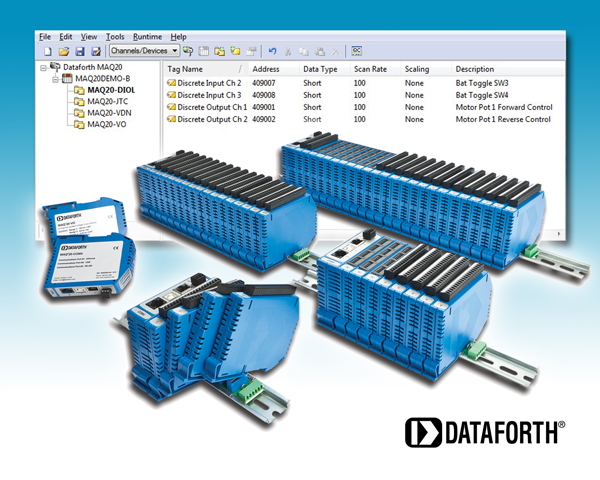Dataforth Broadens MAQ®20 Usability with OPC Server
Press Release
Release Date: Apr 27 2015
 Dataforth’s introduction of an OPC Server for the MAQ®20 Industrial Data Acquisition & Control System ensures data collection and analysis using the MAQ20 is now significantly broader-based and easier to use. The original acronym OPC stood for OLE for Process Control, or Object Linking and Embedding for Process Control. The OPC Foundation has officially renamed it to mean Open Platform Communications; it is also referred to as Open Productivity and Connectivity.
Dataforth’s introduction of an OPC Server for the MAQ®20 Industrial Data Acquisition & Control System ensures data collection and analysis using the MAQ20 is now significantly broader-based and easier to use. The original acronym OPC stood for OLE for Process Control, or Object Linking and Embedding for Process Control. The OPC Foundation has officially renamed it to mean Open Platform Communications; it is also referred to as Open Productivity and Connectivity.
"Our MAQ20 OPC Server provides a common interface to the MAQ20 system that is usable by any SCADA, HMI, or other custom software that is an OPC client," says Engineering Manager John Lehman. "This eliminates the need for a custom interface or driver when using the MAQ20 with industry standard software, and it enables real time information exchange on local hosts or over distributed networks."
The MAQ20 OPC server uses Kepware Technologies’ KEPServerEX OPC Server and Modbus TCP driver, which have been configured for the MAQ20 system.
OPC servers consist of three basic parts: Channels, Devices, and Tags.
A channel represents the communication medium from the host computer to one or more devices. For example, the MAQ20-COM4 communications module has an RS-485 port and an Ethernet port; a serial or Ethernet connection between the host computer and the MAQ20 would be a channel in an OPC server.
A device is the hardware with which the server communicates. The device driver provides the interface to the data acquisition hardware. For the MAQ20 OPC server, the MAQ20 Data Acquisition System is the device.
A tag represents addresses within the hardware with which the server communicates. The KEPServerEX OPC Server allows both Dynamic tags and user-defined Static tags. Dynamic tags are entered in the OPC client and specify device data. User-defined Static tags are created in the server and support tag scaling. When the MAQ20 system is used as the device, tags are assigned to the addresses within the MAQ20 I/O modules and communications modules from which data is read and to which data is written.
For additional details and to learn how to build an OPC server for the MAQ20, download the MAQ20 OPC Server User Manual.
The OPC standard was first released in 1996 and remains today "the interoperability standard for the secure and reliable exchange of data in the industrial automation space and in other industries," according to the OPC Foundation, which develops and maintains the standard.
"Adding the MAQ20 OPC server is like having a translator available that allows simple interfacing to the MAQ20 Data Acquisition System in any new or existing process control or monitoring application," says Bob Smith, Dataforth’s VP of Sales and Marketing.
Dataforth was established in 1984 and is the world leader in data acquisition and control, signal conditioning, and data communication products for industrial applications. Worldwide, our products provide rugged signal and data integrity and wide spectrum accuracy. All Dataforth products are manufactured in the USA and have been RoHS Compliant since 2006. The Dataforth Quality Management System is ISO9001:2015 registered.
For additional information, call 800-444-7644 toll-free or email sales@dataforth.com.
Was this content helpful?
Thank you for your feedback!






